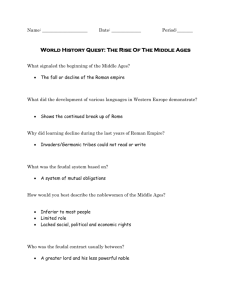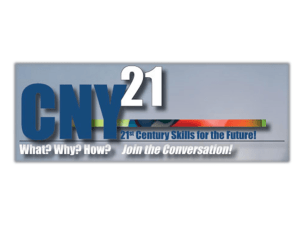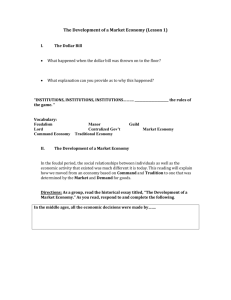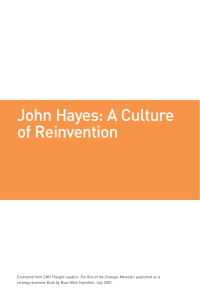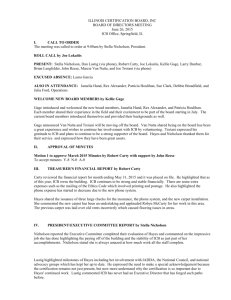Reading Assignment Questions
advertisement
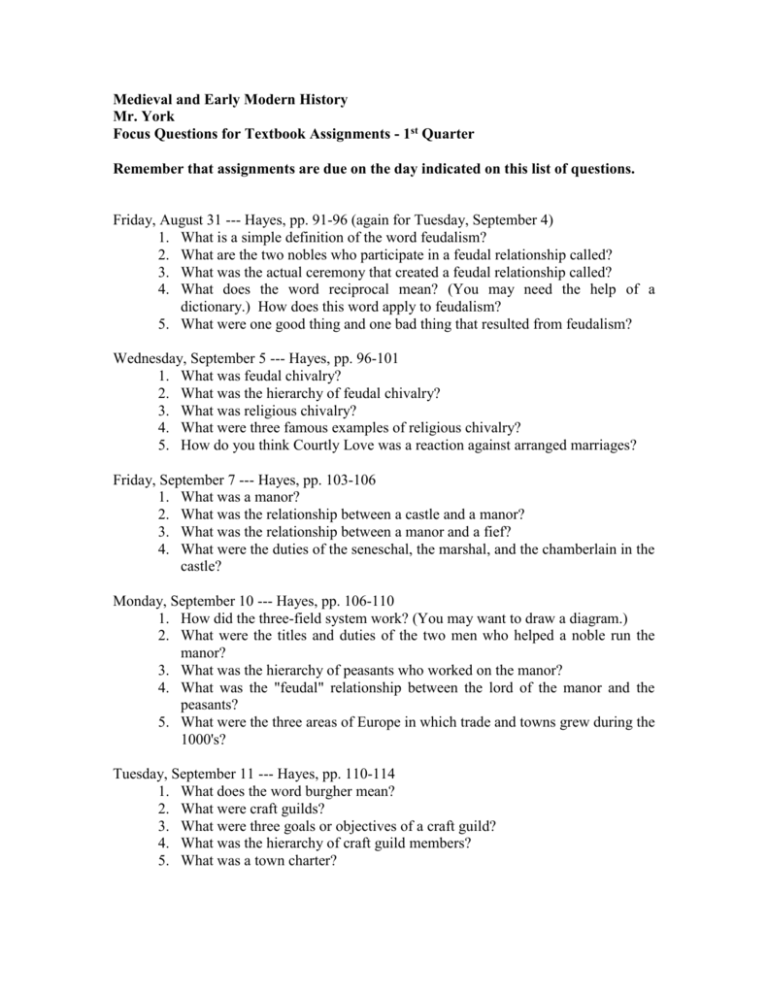
Medieval and Early Modern History Mr. York Focus Questions for Textbook Assignments - 1st Quarter Remember that assignments are due on the day indicated on this list of questions. Friday, August 31 --- Hayes, pp. 91-96 (again for Tuesday, September 4) 1. What is a simple definition of the word feudalism? 2. What are the two nobles who participate in a feudal relationship called? 3. What was the actual ceremony that created a feudal relationship called? 4. What does the word reciprocal mean? (You may need the help of a dictionary.) How does this word apply to feudalism? 5. What were one good thing and one bad thing that resulted from feudalism? Wednesday, September 5 --- Hayes, pp. 96-101 1. What was feudal chivalry? 2. What was the hierarchy of feudal chivalry? 3. What was religious chivalry? 4. What were three famous examples of religious chivalry? 5. How do you think Courtly Love was a reaction against arranged marriages? Friday, September 7 --- Hayes, pp. 103-106 1. What was a manor? 2. What was the relationship between a castle and a manor? 3. What was the relationship between a manor and a fief? 4. What were the duties of the seneschal, the marshal, and the chamberlain in the castle? Monday, September 10 --- Hayes, pp. 106-110 1. How did the three-field system work? (You may want to draw a diagram.) 2. What were the titles and duties of the two men who helped a noble run the manor? 3. What was the hierarchy of peasants who worked on the manor? 4. What was the "feudal" relationship between the lord of the manor and the peasants? 5. What were the three areas of Europe in which trade and towns grew during the 1000's? Tuesday, September 11 --- Hayes, pp. 110-114 1. What does the word burgher mean? 2. What were craft guilds? 3. What were three goals or objectives of a craft guild? 4. What was the hierarchy of craft guild members? 5. What was a town charter? Thursday, September 20 --- Hayes, pp. 116-120 1. What was the "Commonwealth of Christendom?" 2. What does the word sacrament mean? 3. What are the three categories that our text uses to divide the seven sacraments? 4. Which sacraments go under each category? (You may want to create a chart.) 5. What did Gratian do to help the Church? Monday, September 24 --- Hayes, pp. 120-124 1. What is the difference between a monk and a friar? 2. What was the name of the new monastic order created to reform the Benedictine order? (Why does the name of this new monastic order sound familiar?) Who was the leader of this new order? 3. What were the two main groups of friars called? 4. What does the word heresy mean? (You may need the help of a dictionary.) 5. What did the Albigensians believe? Tuesday, September 25 --- Hayes, pp. 138-142 1. Based on the movie we just saw why were cathedrals so large? 2. What are the important characteristics of Romanesque churches? 3. What are the important characteristics of Gothic churches? 4. When did the Gothic style become the dominant type of architecture? 5. What is the name of one famous Gothic cathedral in France? Monday, October 1 --- Hayes, pp. 169-172 (again for Tuesday, October 2) 1. What battle took place in 1066 that established Norman rule over England? 2. Why is it correct to say that the French now ruled England? 3. What were three things William I did that must have made English nobles hate him? 4. What were three things Henry I did that must have made English nobles like him? 5. What do you think the goals were of William I and Henry I? Wednesday, October 3 --- Hayes, pp. 172-174 1. What was the Assize of Clarendon? 2. What is the difference between a grand jury and a petit jury? 3. What does the word precedent mean? 4. How was Henry II's wife connected to Courtly Love? 5. Why did Henry II and Thomas Becket come into conflict? Monday, October 8 --- Hayes, pp. 174-176 1. Who was the King of England known as "Lackland" and "Softsword?" 2. What does the word interdict mean? 3. What was the important document John was forced to sign in 1215? 4. What are two important parts of this document that weakened the power of the king? 5. What was the important principle about law in England that was established in this document? Tuesday, October 9 --- Hayes, pp. 176-178 1. When Henry III and the barons of England were in conflict, whom did they ask to act as judge to settle their dispute? 2. Who was Simon de Montfort? 3. What were the two neighboring countries that Edward I conquered to create Great Britain? 4. What four groups of people were represented in the "Model Parliament" of 1295? 5. How were these four groups eventually organized in Parliament? Monday, October 22 ---pp. 158-161 1. How did Hugh Capet begin to change the nature of the monarchy in France? 2. What was the name of the province ruled directly by the king? 3. What group in French society resisted the growth in power of the monarchy? 4. Who were the two men at the center of the alliance between the Church and the monarchy? 5. Why did the leaders of many towns begin to support the monarchy? Tuesday, October 23 --- pp. 161-163 (and again on Wednesday, October 24) 1. Who was Philip II's great enemy during the late 1100's? 2. Who were the two important sons of this great enemy? 3. How did Philip II avoid defeat against these three men? 4. How did the battle of Bouvines help keep France safe? 5. Why do you think some historians call Philip II the "father of France?" Thursday, October 25 --- pp. 164-167 (and again on Monday, October 29) 1. What did Louis IX do to establish moral leadership in France? 2. What are two changes he made to help unify France? 3. How did Louis IX's moral leadership weaken the influence of the Church in France? 4. Why wasn't Philip IV really "fair," especially to the Church? 5. What was the "Estates General" and why did Philip IV organize it?



